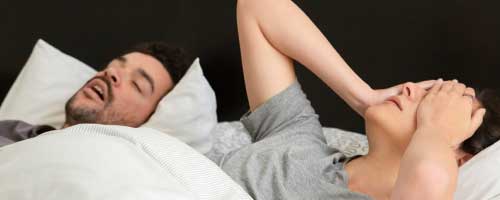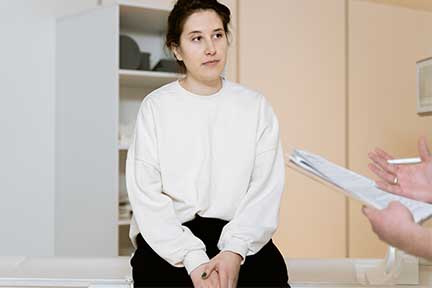Obstructive Sleep Apnea Explained in Plain English!

Obstructive Sleep Apnea
(most common form of sleep apnea)
Sleep Apnea Signs: loud snoring, no breathing for a period of time despite attempts to breathe
Sleep Apnea Symptoms: very tired during the day, falling asleep at the wheel when driving, headaches in the morning, sore throat, and not feeling rested no matter how much you sleep
Top 6 signs doctors look for to determine possible sleep apnea.
Top 8 treatments for sleep apnea.
Top 8 reasons to treat sleep apnea.
Obstructive Sleep Apnea is becoming more common (more than 6% of the population) as our population becomes more obese. Several factors contribute to the development of sleep apnea, the key one being weight. Sleep apnea is very much an anatomic problem, meaning that it's a matter of having the space in the throat for the air to go down to the lungs. As with other matters of anatomy, medications cannot really take care of the problem (unless it's a diet pill — and even then, diet pills rarely work long term). The space of the throat must be adjusted somehow to take care of the problem.

As a family physician, when I see someone for a physical, I always evaluate for possible sleep apnea if they have some of the anatomic features below. The first question I ask is if they snore. Then I ask if they feel tired during the day. If so, then I ask them to have their bed partner stay up and watch them snore. If it appears that they stop breathing, then I immediately refer them to have a sleep study done. Even if the bed partner does not notice definite stopping of respirations, I may still refer for a sleep study to be sure.
The physical signs I look for include...
- obesity
- short neck (like a football lineman, not like a ballerina)
- thick neck
- receding chin or jaw (the opposite of a prominent chin)
- large tonsils, and
- low uvula position when checking the throat (the uvula's the thingy that hangs down in the back of the throat when you say "ah").
- This may be from a big tongue or a low soft palate. A big uvula is also a bad sign.
These signs all point to very little space for air to travel down to the lungs when lying down. As one gains more weight, the fat not only accumulates on the outside where you can see it, it also accumulate on the inside tissues, including the back of the throat. When you sleep, everything relaxes, including the muscles in the back of the throat, which usually hold it open. If you are so relaxed that the muscles also relax, then the tissues in the back of the throat (such as the tonsils uvula, and soft palate) can fall down and block your airway! So you attempt to breathe for a while, but you can’t get any air in or out. After about 30 seconds of trying unsuccessfully to breathe, you brain suffers from lack of oxygen and wakes you up temporarily to take a deep breath and breathe normally again until you fall back into deep sleep, when the muscles become very relaxed again.
The cycle repeats itself all night long. People have been known to repeat this cycle hundreds of times just in 1 night. This cycle of holding your breath and briefly waking up severely disrupts sleep, but you may not even know that you are waking up! You are so chronically tired from not being able to enter deep sleep that you don't even know that you are snoring and briefly waking up. Not getting a good night's sleep is why sleep apnea sufferers are so tired during the day.
Now that you understand the real cause of sleep apnea, you can begin to take care of it!
Top 8 treatments for Sleep Apnea
Treatment — least invasive (non-surgical and cheap) to the most invasive (surgical).
-
Weight Loss.
Losing weight can help most people if they are overweight. -
Decreasing Alcohol Consumption.
This can cause the tissues in the back of the throat to relax too much and fall down to block the airway. Other medications that have a sedative effect can also cause this problem. -
Stop smoking.
This can cause swelling of the tissues in the nose and throat. It also decreases the oxygen absorption in the lungs. -
Raising the head of the bed by 30 degrees for example.
You can change the way the throat tissues hang down just by not laying completely flat at night. -
A Sleep Apnea pillow.
These may help with mild sleep apnea by making it uncomfortable to lie flat on the back. There is usually a bulge in the middle of the pillow so you have to lie on your side. You can make your own pillow by putting an object in the middle, such as a tennis ball. -
Treat your allergies and acid reflux.
-
See the dentist
Perhaps there are dental devices that can help keep the throat open. -
CPAP (continuous positive airway pressure).
This is fitted after you've seen a sleep specialist who can diagnose sleep apnea formally with a sleep study. CPAP. It's basically a device that blows air into your throat all night long to keep the airways open. It can be worn over the mouth or the nose or both. -
Surgery.
Removing large tonsils, removing the adenoids, reducing the uvula and soft palate, nasal septum straightening, or changing jaw anatomy can all potentially help. Surgery should be the last option after trying everything else. There is no completely safe surgery, and results are never completely perfect.
Why is treating Obstructive Sleep Apnea is so important? I understand that some of the treatments seems very extreme, and most people don't like to use the CPAP (although if you suffer enough with sleep apnea, eventually you'd be thankful that at least CPAP exists). There is no nice and simple pill to treat sleep apnea (unless you have allergies or acid reflux/heartburn). However, not treating sleep apnea will reduce your life expectancy, increase your life insurance rates, bother your bed partner, cause many other medical problems (see below), and keep you feeling miserably tired.
Top 8 reasons to treat sleep apnea.
Other than feeling tired, there are many other very serious problems with obstructive sleep apnea.
-
Falling asleep at the wheel:
Every year 1500 Americans die when falling asleep at the wheel. Even if you don't die or become seriously injured, can you imagine hurting other people because you fell asleep at the wheel? What if you drove into oncoming traffic and killed a child? In certain states, you could actually go to jail for driving recklessly when you know you suffer from untreated sleep apnea. Your car insurance may decide to drop you. Sleep apnea increases the risk of having a car accident by 7 times! -
Heart disease:
When you don't get oxygen, your heart suffers by having to work extra hard to pump blood to the brain while not getting enough oxygen itself! -
High Blood Pressure.
-
Stroke.
-
Impotence!
Actually, erectile dysfunction (for which Viagra is well known) is very much related to heart disease, blood pressure, stroke, and diabetes. Oxygen deprivation causes various types of vascular disease (blood vessel disease) including the blood vessels in the penis. -
Diabetes.
-
Headaches:
You get headaches from not sleeping enough and not getting enough oxygen to the brain. -
Sore throat:
Because of the snoring, the dryness and frequent vibrations of the back of the throat causes it to be sore.
Unfortunately, the SleepPhones System cannot help the person who suffers from sleep apnea, as it is an anatomic problem as described above. I do not recommend using the SleepPhones System to block out your own snoring sounds. If you use CPAP, it may be too much to wear the mask and the headband. However, the SleepPhones System is perfect for the bed partner or roommate! It helps to block out the noise of snoring and/or CPAP machines. Get relief from Second-Hand Snoring!
Copyright © Wei-Shin Lai, MD 2007
Find more at our resource page dedicated to Snoring.
